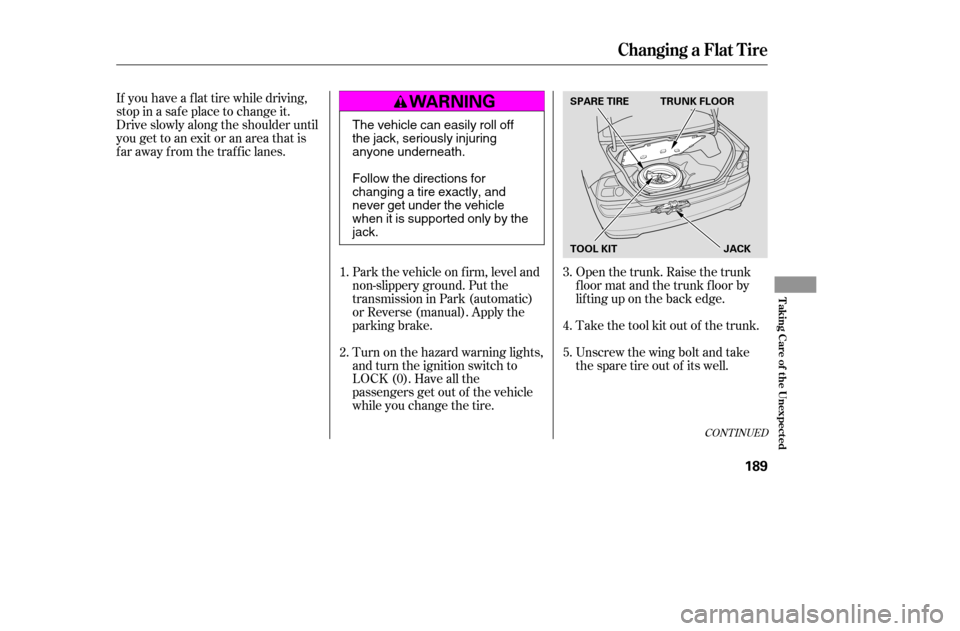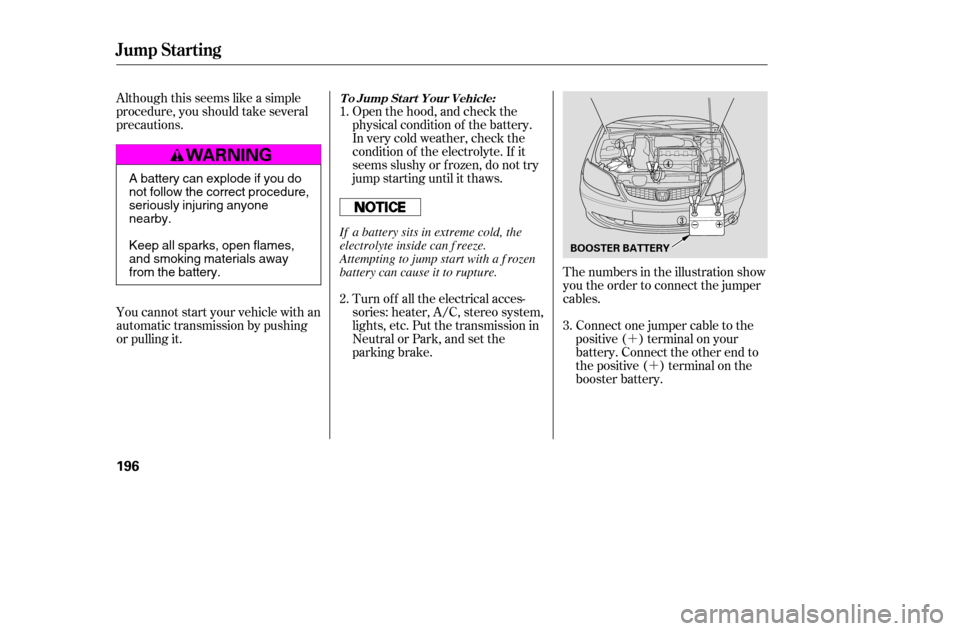Page 157 of 226
Check the f luid level with the engine
at normal operating temperature.Park the vehicle on level ground.
Shut of f the engine. Remove the dipstick (yellow loop)
f rom the transmission, and wipe it
with a clean cloth.
Remove the dipstick and check
the f luid level. It should be
between the upper and lower
marks.
Insert the dipstick all the way into
the transmission securely as
shown in the illustration.
NOTE: For accurate results, wait at
least 60 seconds, and no more than
90 seconds, af ter turning of f the
engine to check the f luid level. 3.
4.
1. 2.
CONT INUED
Automatic Transmission Fluid
Maint enance
165
DIPSTICK (A/T)
LOWER MARK
UPPER MARK
DIPSTICK (CVT)
DIPSTICK (A/T)
�����—�����—�����y�
���������
���y���
�(���%�������y���
�����y
Page 158 of 226

If the level is below the lower
mark, add f luid into the f iller hole
to bring it to the upper mark (On
CVT model, the HOT side’s upper
mark).
Remove the dipstick and check the
f luid level. There is a HOT side and a
COLD side on the dipstick. It should
be between the upper and lower
marks on the HOT side. To thoroughly f lush the transmission,
the technician should drain and ref ill
it with Honda ATF-Z1, then drive the
vehicle f or a short distance. Do this
three times. Then drain and ref ill the
transmission a final time.
Insert the dipstick all the way back
into the transmission securely as
shown in the illustration.
If you are not sure how to add f luid,
contact your dealer.
The transmission should be drained
and ref illed with new f luid according
to the time and distance recommen-
dations in the maintenance schedule.
Pour the f luid slowly and caref ully
so you do not spill any. Clean up
any spills immediately; it could
damage components in the engine
compartment.
Always use Honda ATF-Z1
(Automatic Transmission Fluid). If
it’s not available, you may use a
DEXRON
III automatic
transmission f luid as a temporary
replacement. However, continued
use can af f ect the shif t quality.
Have the transmission f lushed and
ref illed with Honda ATF-Z1 as
soon as it is convenient.
5.
6.
On CVT model
Automatic Transmission Fluid
166
UPPER MARK
DIPSTICK (CVT)
LOWER MARK
�����—�����—�����y�
�������������y���
�(���%�������y���
�����y
Page 177 of 226

If you need to park your vehicle f or
an extended period (more than one
month), there are several things you
should do to prepare it f or storage.
Proper preparation helps prevent
deterioration and makes it easier to
get your vehicle back on the road. If
possible, store your vehicle indoors.Fill the f uel tank.
Change the engine oil and f ilter. Block the rear wheels.
If the vehicle is to be stored f or a
longer period, it should be
supported on jackstands so the
tires are of f the ground.
Wash and dry the exterior
completely.
Cleantheinterior.Makesurethe
carpeting, floor mats, etc., are
completely dry. Cover the vehicle with a
‘‘breathable’’ cover, one made
f rom a porous material such as
cotton. Non-porous materials, such
as plastic sheeting, trap moisture,
which can damage the paint.
Leave the parking brake off. Put
the transmission in Reverse
(manual) or Park (automatic). Leave one window open slightly (if
the vehicle is being stored
indoors).
If possible, periodically run the
engine until it reaches f ull
operating temperature (the
cooling f ans cycle on and of f
twice). Pref erably, do this once a
month.
If you store your vehicle f or 1 year or
longer, have your dealer perf orm the
inspections called f or in the 2 years/
30,000 miles (48,000 km)
maintenance schedule (Normal
Conditions) as soon as you take it
out of storage (see page ). The
replacements called f or in the
maintenance schedule are not
needed unless the vehicle has
actually reached that time or mileage.
To minimize sticking, apply a
silicone spray lubricant to all door
and trunk seals. Also, apply a
vehiclebodywaxtothepainted
surfaces that mate with the door
and trunk seals.
Support the f ront wiper blade
arms with a f olded towel or rag so
they do not touch the windshield.
Disconnect the battery.
153
Vehicle Storage
Maint enance
185
�����—�����—�����y�
�������������y���
�(���%�������y���
�����y
Page 180 of 226

Park the vehicle on f irm, level and
non-slippery ground. Put the
transmission in Park (automatic)
or Reverse (manual). Apply the
parking brake.
Turn on the hazard warning lights,
and turn the ignition switch to
LOCK (0). Have all the
passengers get out of the vehicle
while you change the tire.Take the tool kit out of the trunk.
Unscrew the wing bolt and take
the spare tire out of its well.
Open the trunk. Raise the trunk
f loor mat and the trunk f loor by
lif ting up on the back edge.
If you have a f lat tire while driving,
stop in a saf e place to change it.
Drive slowly along the shoulder until
you get to an exit or an area that is
far away from the traffic lanes.
5.
4.
3.
2.
1.
CONT INUED
Changing a Flat T ire
T aking Care of t he Unexpect ed
189
SPARE TIRE TRUNK FLOOR
TOOL KIT JACK
The vehicle can easily roll off
the jack, seriously injuring
anyone underneath.
Follow the directions for
changing a tire exactly, and
never get under the vehicle
when it is supported only by thejack.
�����—�����—�����y�
�������������y���
�(���%�������y���
�����y
Page 185 of 226

Diagnosing why the engine won’t
start f alls into two areas, depending
on what you hear when you turn the
key to START (III):You hear nothing, or almost
nothing. The engine’s starter
motor does not operate at all, or
operates very slowly.
You can hear the starter motor
operating normally, or the starter
motor sounds like it is spinning
f aster than normal, but the engine
does not start up and run. Check these things:
When you turn the ignition switch to
START (III), you do not hear the
normal noise of the engine trying to
start. You may hear a clicking sound
or series of clicks, or nothing at all.
Check the transmission interlock.
If you have a manual transmission,
the clutch pedal must be pushed
all the way to the f loor or the
starter will not operate. With an
automatic transmission, it must be
in Park or Neutral.
Turn the ignition switch to ON (II).
Turn on the headlights, and check
their brightness. If the headlights
areverydimordonotcomeonat
all, the battery is discharged. See on page . Turn the ignition switch to START
(III). If the headlights do not dim,
check the condition of the f uses. If
the f uses are OK, there is
probably something wrong with
the electrical circuit f or the
ignition switch or starter motor.
You will need a qualif ied
technician to determine the
problem (see
on page ).
If the headlights dim noticeably or
go out when you try to start the
engine, either the battery is dis-
charged or the connections are
corroded. Check the condition of
the battery and terminal connec-
tions (see page ). You can
then try jump starting the vehicle
f rom a booster battery (see page
).209
184
196
196
Nothing Happens or the Starter
Motor Operates Very Slowly
Jump Starting Emergency T owing
If theEngineWon’tStart
194
�����—�����—�����y�
�������������y���
�(���%�������y���
�����y
Page 187 of 226

�´�´
Although this seems like a simple
procedure, you should take several
precautions. Open the hood, and check the
physical condition of the battery.
In very cold weather, check the
condition of the electrolyte. If it
seems slushy or f rozen, do not try
jump starting until it thaws.
You cannot start your vehicle with an
automatic transmission by pushing
or pulling it. The numbers in the illustration show
you the order to connect the jumper
cables.
Connect one jumper cable to the
positive ( ) terminal on your
battery. Connect the other end to
the positive ( ) terminal on the
booster battery.
Turn of f all the electrical acces-
sories: heater, A/C, stereo system,
lights, etc. Put the transmission in
Neutral or Park, and set the
parking brake.
3.
1. 2.To Jump Start Your Vehicle:
Jump Starting
196
BOOSTER BATTERY
A battery can explode if you do
not follow the correct procedure,
seriously injuring anyonenearby.
Keep all sparks, open flames,
and smoking materials away
from the battery.
If a battery sits in extreme cold, the
electrolyte inside can f reeze.
Attempting to jump start with a f rozen
battery can cause it to rupture.
�����—�����—�����y�
���������
���y���
�(���%�������y���
�����y
Page 200 of 226

�µ�µ
CONT INUED
If , due to damage, your vehicle must
be towed with the f ront wheels on
the ground, do the f ollowing:
If your vehicle needs to be towed,
call a prof essional towing service or
organization. Never tow your vehicle
with just a rope or chain. It is very
dangerous. There are two ways to
tow your vehicle.
The operator
loads your vehicle on the back of a
truck.
The tow
truck uses two pivoting arms that go
under the tires (f ront or rear) and lif t
them of f the ground. The other two
tires remain on the ground. Release the parking brake.
Shif t the transmission to Neutral.
Release the parking brake.
Start the engine.
ShifttoD,thentoN.
Turn of f the engine.
With the f ront wheels on the ground,
it is best to tow the vehicle no farther
than 50 miles (80 km), and keep the
speedbelow35mph(55km/h).
If your vehicle is equipped with a
f ront spoiler, remove it bef ore
towing so it is not damaged.
Manual Transmission and Continuously
Variable Transmission (CVT):
Automatic Transmission:
Emergency T owing
Flat -bed Equipment
Wheel-lif t Equipment
This is the best way to trans-
port your vehicle.
T his is
an acceptable way to tow your
vehicle.
T aking Care of t he Unexpect ed
209
Improper towing preparation will
damage the transmission. Follow the
above procedure exactly. If you cannot
shif t the transmission or start the
engine (automatic transmission), your
vehicle must be transported with the
f ront wheels of f the ground.
�����—�����—�����y�
���������
���y���
�(���%�������y�����
���y
Page 203 of 226
The engine number is stamped into
the engine block. It is on the f ront.
The transmission number is on a
label on top of the transmission.
Identif ication Numbers
T echnical Inf ormation
213
AUTOMATIC TRANSMISSION NUMBER
ENGINE NUMBER
MANUAL TRANSMISSION
NUMBER
�����—�����—�����y�
�������������y���
�(���%�������y�����
���y